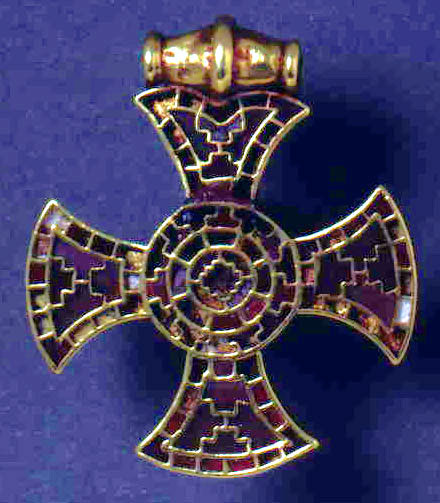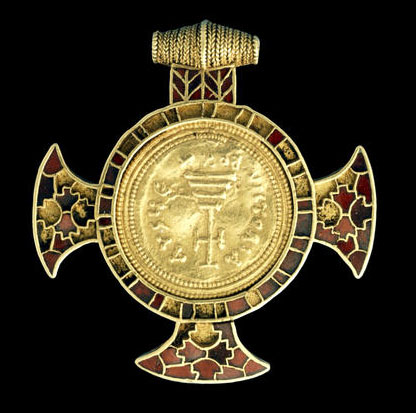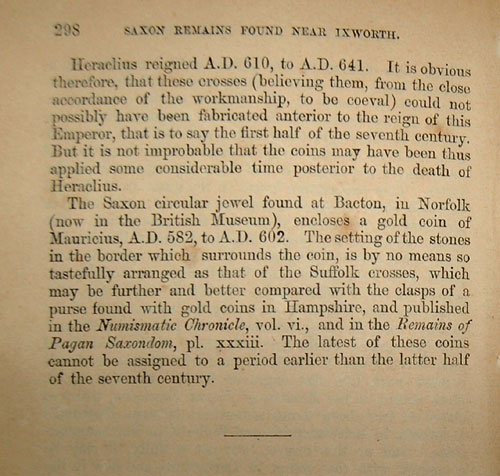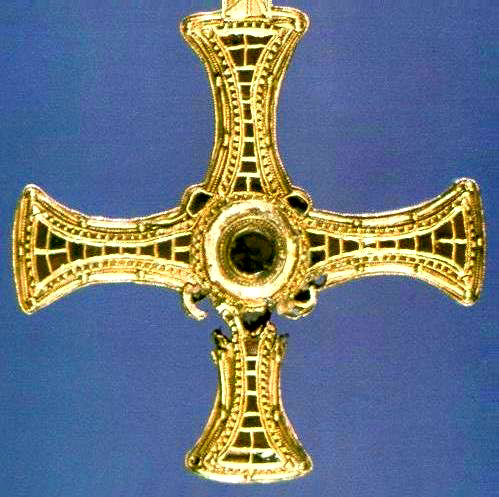 |
 |
What follows is the published text of the Ixworth Cross, taken from the Journal of the Suffolk Institute of Archaeology, Volume III, pages 296 to 298. This volume was dated 1863, but this was, in fact, a reprint of a previous article published in Smith's magazine called Collecteana Antiqua, Volume 4, page 162 onwards. The publication date of this is unclear, but it must have been at least a year after the finds were made.
 |
 |

|

|
 gravel pit at Lakenheath, near Brandon, in Suffolk, a few years since". Now known as 'The Wilton Cross' |

|
|
St Cuthbert died in the year 687, and was buried at the monastery on the island of Lindisfarne. Eventually his body was removed to Durham Cathedral, and in 1827 his tomb was opened and this gold pectoral cross was discovered around his neck. This cross must date from a similar period to the Ixworth Cross, but presumably was made in a Northern workshop. St Cuthbert's cross is inlaid with garnets, just as in our cross, and the overall shape is similar. The association of such a cross with a Bishop, as Cuthbert became in 685, may indicate that the Ixworth Cross could have a similar background. Was the Ixworth Cross also the property of a Bishop or similar highly placed churchman? |

|
|
At lectures given at Sutton Hoo in July 2014, Dr Sam Lucy advanced our ideas about these crosses. Beginning with the Trumpington Cross, which is a modern and well recorded excavation, we find that the reverse of this cross contains small brackets which were used to sew the cross on to a garment at the neck. Gold and garnet link pins were also found by the head which were used to fasten a veil or headdress. This bed burial and associated jewellery is undoubtedly a female grave. This leads us to the possibility that all the bed burials so far discovered may well be female graves, and that these so-called pectoral crosses were not indicative of male bishops, but of high status Christian women, who themselves may have led a female religious community. The radio carbon dating obtained for the Trumpington body is from 665 to 680 AD. Re-examination of the illustrated iron fittings, described above as found with the Ixworth/Stanton Cross, has led to the conclusion that this was also a bed burial. Taken together with the associated fibula or brooch, it is easy to conclude that the grave occupant was most probably a woman. Where does this leave St Cuthbert's Cross? Cuthbert died in a hermit's cell on Inner Farne island on or about 20th March, 687 AD. It is immediately unlikely that such an ascetic would have worn a valuable jewel. The body was taken to Lindisfarne for burial. Even at Lindisfarne the grave was soon opened so that his body could be moved to a new resting place at the high altar in 698. In 875 the body was removed to avoid viking raids, and apparently it wandered for seven years until located at Chester Le Street, where King Aethelstan is recorded as visiting the shrine. He left valuable textiles to adorn the shrine. There was a further move to Ripon in 995, and a final move to Durham. At Durham the shrine was moved more than once until the great Norman cathedral was built by 1104. It seems quite probable that the cross was a gift from a female pilgrim, and could have been inserted into the coffin as early as the 690s. |
| Go to Anglo Saxons Homepage |
Created 25th March 2007 Update 17th March 2012 and new aspects added July 22nd 2014. Winfarthing added 11th December, 2017. | Go to Home Page |